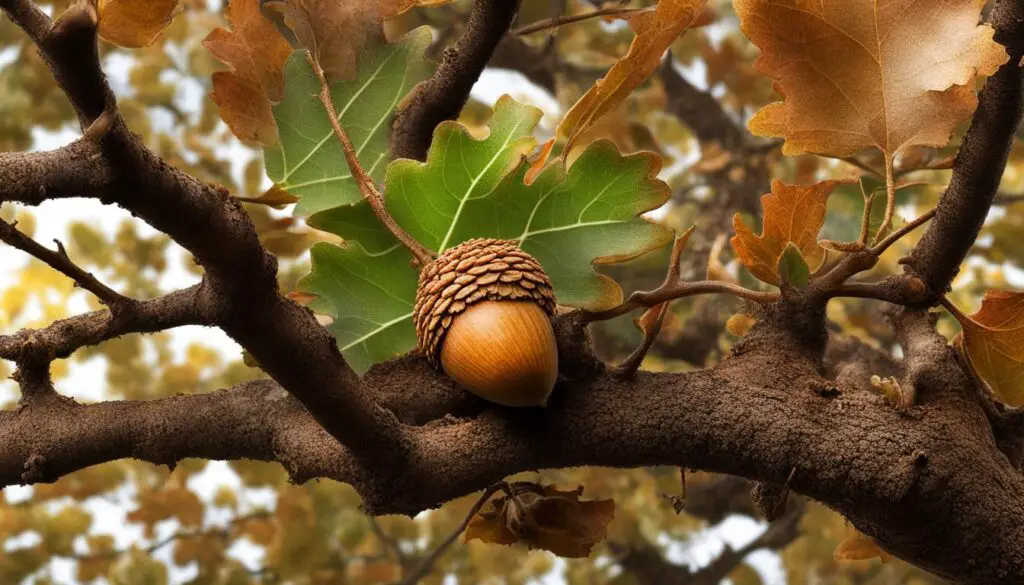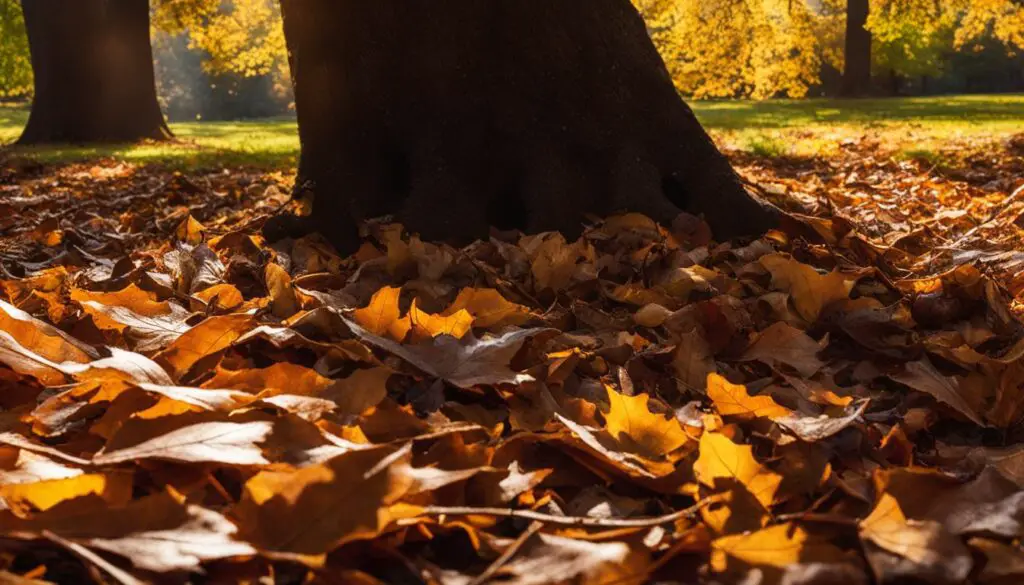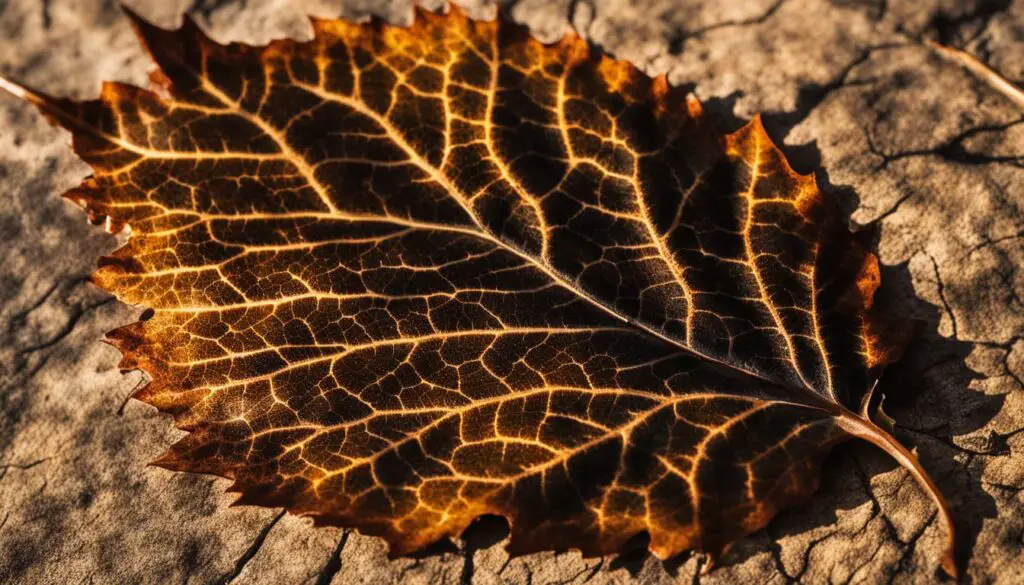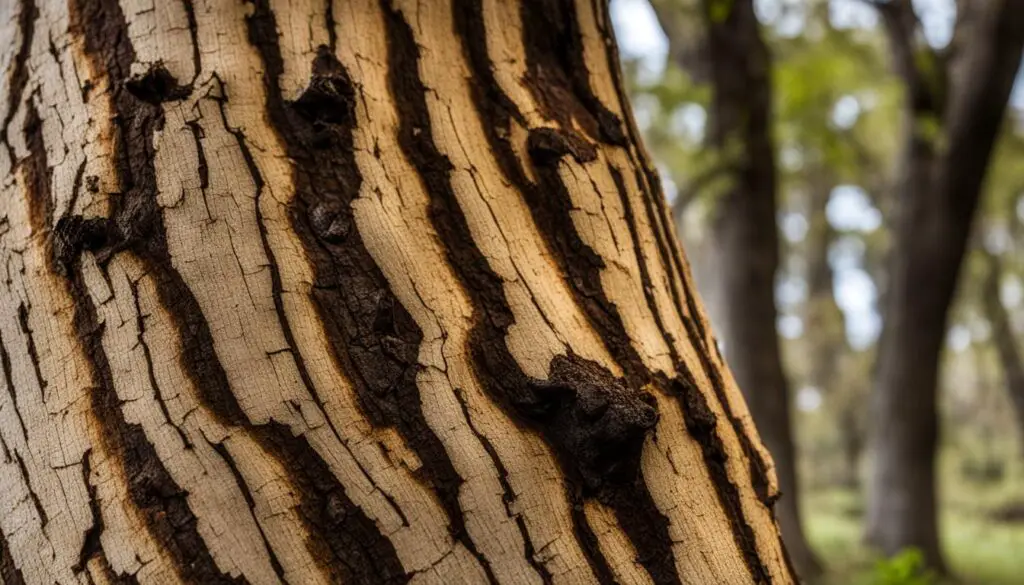Oak trees are a familiar sight in many landscapes, known for their towering presence and majestic beauty. But have you ever wondered what those brown things are that fall from oak trees? From small seeds to fallen leaves, oak trees produce a variety of brown things that play a vital role in the ecosystem. In this article, we will explore the different types of brown things that fall from oak trees and their significance in the natural world.
Key Takeaways:
- Oak tree seeds, also known as acorns, are the most common brown things that fall from oak trees. They serve as a food source for wildlife and contribute to forest regeneration.
- Oak tree debris, including fallen leaves, branches, and bark, plays a crucial role in the ecosystem by providing habitat, promoting nutrient cycling, and supporting the growth of other plants.
- Understanding the life cycle of oak tree seeds and the significance of oak tree debris helps us appreciate their importance in the natural world.
Understanding Oak Tree Seeds (Acorns)
Oak tree seeds, also known as acorns, are the most common brown things that fall from oak trees. Acorns are the fruit of the oak tree and are typically small in size, with a hard shell and a cap on top. They contain a seed that has the potential to grow into a new oak tree. Acorns are a valuable food source for many animals, including squirrels, birds, and deer. They also play a role in oak tree reproduction by being dispersed and planted in new areas.
Acorns, with their hard shells, protect the seed inside and ensure its survival. The cap on the top of the acorn acts as a protective shield, preventing insects and other animals from accessing the seed. This mechanism allows the acorn to safely fall from the oak tree and settle on the ground.
Once on the ground, acorns become a vital food source for many wildlife species. Squirrels are known for their habit of collecting and burying acorns for future consumption. This behavior also helps with the dispersal of acorns, as squirrels may forget or fail to retrieve some of their hidden caches. Birds, such as jays and woodpeckers, also play a role in spreading acorns by caching or dropping them in various locations.
Aside from being a food source, acorns contribute to the reproduction and growth of oak trees. When an acorn germinates, it sends out a root and a shoot, eventually growing into a young oak seedling. With time, it develops into a mature oak tree. This process is essential for the expansion and regeneration of oak tree populations.
Understanding the significance of oak tree seeds, also known as acorns, allows us to appreciate the ecological importance of these brown things that fall from oak trees. From providing nutrition to wildlife to facilitating oak tree reproduction, acorns play a fundamental role in the natural world.
The Role of Oak Tree Debris in the Ecosystem
Oak tree debris, including fallen leaves, twigs, branches, and bark, plays an important role in the ecosystem. When these brown things fall from oak trees, they provide habitat and food for a variety of organisms. Fallen leaves, for example, create a layer of organic matter on the forest floor, known as leaf litter, which supports a diverse community of microorganisms, insects, and other small animals. The decomposition of oak tree debris also contributes to the nutrient cycle, enriching the soil and supporting the growth of other plants.
As oak tree debris accumulates on the forest floor, it creates a microenvironment that supports a wide range of organisms. Microorganisms, such as fungi and bacteria, break down the decaying organic matter, releasing nutrients into the soil. This nutrient-rich soil provides a fertile ground for the growth of other plants, contributing to a healthy and thriving forest ecosystem.
The leaf litter created by oak tree debris acts as a protective layer, providing shelter for small animals, such as insects and amphibians. It also serves as a food source for detritivores, organisms that feed on dead organic material. These detritivores play a crucial role in decomposing the oak tree debris, further aiding in nutrient recycling.
Additionally, fallen branches and bark from oak trees provide nesting sites and shelter for birds, squirrels, and other small mammals. These animals rely on these natural structures for protection from predators and harsh weather conditions.
In summary, oak tree debris plays a vital role in the ecosystem by providing habitat and food for various organisms, contributing to the nutrient cycle, and supporting the growth of other plants. The presence of oak tree debris enriches the forest ecosystem, promoting biodiversity and ensuring the sustainability of the natural environment.
The Life Cycle of Oak Tree Seeds
The life cycle of oak tree seeds, or acorns, begins when the oak tree produces flowers. These flowers are wind-pollinated and develop into small, green acorns. As the acorns mature, they turn brown and fall from the oak tree. Many acorns are eaten by animals, but some manage to escape and germinate.
Acorns have a unique germination process that involves a period of dormancy, during which the acorn remains dormant until the conditions are favorable for growth. Once the acorn sprouts, it develops into a young oak seedling and eventually grows into a mature oak tree.

| Stage | Description |
|---|---|
| Flowering | The oak tree produces flowers. |
| Acorn Development | Flowers develop into green acorns. |
| Maturation | Acorns turn brown and fall from the oak tree. |
| Germination | Some acorns escape consumption and sprout under favorable conditions. |
| Seedling Stage | The sprouted acorn develops into a young oak seedling. |
| Maturity | The oak seedling grows into a mature oak tree. |
The Importance of Oak Tree Seeds for Wildlife
Oak tree seeds, or acorns, are a crucial food source for many wildlife species. Animals like squirrels, deer, birds, and small mammals rely on acorns as a source of nutrition. They eat the acorns directly or store them for future consumption. This dependency on oak tree seeds helps these animals survive through the winter months when other food sources may be limited.
Additionally, the dispersal of acorns by animals plays a role in spreading oak trees to new locations and contributing to forest regeneration. Animals often bury acorns in the ground, unintentionally planting them. This process helps oak trees to expand their range and establish new populations.
The importance of oak tree seeds for wildlife is evident in the interdependence between animals and oak trees. This relationship highlights the essential role that oak trees play in providing food and habitat for numerous species in diverse ecosystems.
Understanding the Significance of Oak Tree Debris in Forest Ecology
Oak tree debris, including fallen leaves, branches, and bark, plays a crucial role in forest ecology. When these brown things fall from oak trees, they contribute to the natural processes that sustain the forest ecosystem. Oak tree debris provides habitat for organisms such as insects, fungi, and small animals. It also acts as a natural mulch, helping to retain moisture in the soil and regulate temperature. Decomposition of oak tree debris releases nutrients back into the soil, supporting the growth of other plants and maintaining the overall health and biodiversity of the forest.

Oak tree debris provides habitat for organisms and supports the growth of other plants.
Role of Oak Tree Debris
When oak tree debris, including fallen leaves, branches, and bark, falls from oak trees, it serves multiple purposes in the forest ecosystem. Let’s take a closer look at the significance of each component:
| Component of Oak Tree Debris | Significance in Forest Ecology |
|---|---|
| Fallen Leaves |
|
| Branches |
|
| Bark |
|
The collective presence of oak tree debris supports a rich web of life in the forest, ensuring the sustainability and vitality of the ecosystem. By understanding the significance of these brown things from oak trees, we can appreciate their role in maintaining the health and biodiversity of forests.
Common Leaf Spot Diseases in Oak Trees
Oak trees, like any other plant, can be susceptible to certain diseases. One common ailment that affects oak trees is oak leaf blister, which falls under the category of leaf spot diseases. Oak leaf blister is caused by a fungal pathogen called Taphrina caerulescens. This disease is prevalent among most oak species and can result in distinct visual symptoms on the leaves.
When infected with oak leaf blister, the upper surface of oak leaves develops circular, raised areas that appear yellowish-white. On the lower surface of the leaves, yellowish-brown depressions can be observed. These visual symptoms resemble blisters, which give the disease its name.
Fortunately, oak leaf blister and other leaf spot diseases are typically not severe and do not cause significant damage to the overall health of the tree. As a result, fungicide applications are not necessary for controlling these diseases. Most oak trees can naturally overcome leaf spot diseases and continue to thrive.
It’s important for tree owners to keep an eye on their oak trees and be aware of leaf spot diseases like oak leaf blister. By promptly identifying and understanding these diseases, tree owners can take appropriate measures to maintain the health of their oak trees.
Bacterial Leaf Scorch in Oak Trees
Bacterial leaf scorch is a common oak tree disease caused by the bacterium Xylella fastidiosa. It primarily affects the xylem, the tissue responsible for transporting water and nutrients within the tree. This disease can have detrimental effects on the health and appearance of susceptible oak trees.
The symptoms of bacterial leaf scorch usually appear as a gradual browning of leaf margins, starting from the older foliage and moving outward. The affected leaves may eventually develop necrotic tissue, giving them a scorched appearance. While this disease primarily affects oak trees, it can also impact other tree species, such as elms, sycamores, and maples.
Currently, there is no known cure for bacterial leaf scorch. However, management strategies can help mitigate its impact and prolong the life of infected trees. Seasonal pruning of affected branches can help remove diseased tissue and promote overall tree health. It is also important to provide adequate water during dry periods, as stressed trees are more susceptible to the disease.
In some cases, antibiotic treatments may be used to temporarily alleviate symptoms and slow down the progression of the disease. However, these treatments are not a permanent solution and need to be repeated regularly. In severe cases, infected trees may need to be removed to prevent the spread of the disease to nearby trees.
Image:

| Symptoms of Bacterial Leaf Scorch | Management Strategies |
|---|---|
| Browning of leaf margins, starting from the older foliage and moving outward | Seasonal pruning of affected branches |
| Scorched appearance and necrotic tissue in affected leaves | Providing adequate water during dry periods |
| Gradual decline in overall tree health | Antibiotic treatments to temporarily alleviate symptoms |
| Removal of severely infected trees |
Oak Wilt and Oak Anthracnose
Oak wilt and oak anthracnose are two diseases that can have an impact on the health of oak trees. Understanding these diseases is crucial for effective management and prevention.
Oak Wilt:
Oak wilt is a fast-spreading disease caused by the pathogen Ceratocystis fagacearum. It is primarily transmitted through insect vectors or root grafts between trees. This disease is particularly devastating for red oak trees, often resulting in their death. White oak trees can also be affected, leading to a decline in their health and vigor.
Oak Anthracnose:
Oak anthracnose is caused by a fungal pathogen known as Apiognomonia errabunda. This disease primarily affects oak leaves and can result in leaf spot, twig dieback, and canker formation. Although oak anthracnose can cause aesthetic damage to the tree, it is generally not fatal.
To effectively manage oak wilt and oak anthracnose, it is important to implement proper management strategies. These may include:
- Removal and disposal of infected trees to prevent the spread of the disease.
- Pruning infected branches to promote tree health and prevent further infection.
- Regular monitoring and early detection of symptoms to take timely action.
- Applying appropriate fungicides or treatments, as recommended by certified arborists or tree care professionals.
By implementing these strategies, you can help control the spread of these diseases and protect your oak trees.

Conclusion
The brown things that fall from oak trees, such as acorns and oak tree debris, play a vital role in the ecological balance of our forests. These brown things are not just mere waste or litter but have significant importance in sustaining the natural world around us.
Acorns, the oak tree seeds, serve as a crucial food source for wildlife, including squirrels, birds, and deer. They provide essential nutrients and energy, especially during harsh winters when food may be scarce. Additionally, acorns contribute to forest regeneration by being dispersed and planted in new areas, ensuring the survival and growth of future oak trees.
Oak tree debris, including fallen leaves, branches, and bark, is equally essential in forest ecology. It provides habitat for a variety of organisms, supports nutrient cycling, and aids in the growth of other plants. The decomposition of oak tree debris enriches the soil, promoting the health and biodiversity of the entire forest ecosystem.
While oak trees may face challenges such as leaf spot diseases and infections, proper tree care and management can help maintain their health and vitality. Understanding the ecological importance of these brown things from oak trees enables us to appreciate the delicate balance of nature and the interconnections that sustain life.
FAQ
What are the brown things that fall from oak trees?
The brown things that fall from oak trees are oak tree seeds, also known as acorns, and oak tree debris such as leaves, branches, and bark.
What are oak tree seeds?
Oak tree seeds, also known as acorns, are the fruit of the oak tree. They are small in size, with a hard shell and a cap on top. Acorns contain a seed that can grow into a new oak tree.
What is oak tree debris?
Oak tree debris refers to fallen leaves, twigs, branches, and bark that fall from oak trees. It plays an important role in the ecosystem by providing habitat and food for various organisms and contributing to the nutrient cycle.
Why are oak tree seeds important?
Oak tree seeds, or acorns, are a valuable food source for many animals such as squirrels, birds, and deer. They also play a role in oak tree reproduction by being dispersed to new areas and planted.
What is the ecological significance of oak tree debris?
Oak tree debris, including fallen leaves, branches, and bark, provides habitat for insects, fungi, and small animals. It also acts as a natural mulch, retaining moisture in the soil and contributing to the nutrient cycle.
What are some common diseases that affect oak trees?
Common diseases that affect oak trees include oak leaf blister, bacterial leaf scorch, oak wilt, and oak anthracnose.
How can I control leaf spot diseases in oak trees?
Leaf spot diseases in oak trees, such as oak leaf blister, do not usually require fungicide applications and do not result in significant damage to the overall health of the tree.
What is bacterial leaf scorch and how can it be managed?
Bacterial leaf scorch is a tree disease caused by the bacterium Xylella fastidiosa. Management strategies for bacterial leaf scorch include seasonal pruning, watering during dry periods, and antibiotic treatments to alleviate symptoms temporarily.
What are oak wilt and oak anthracnose?
Oak wilt is a fast-spreading disease caused by the pathogen Ceratocystis fagacearum and affects red oak and white oak trees. Oak anthracnose is caused by the fungal pathogen Apiognomonia errabunda and can result in leaf spot, twig dieback, and canker formation in oak trees.
What is the conclusion?
The brown things that fall from oak trees, such as acorns and oak tree debris, have significant ecological importance. Acorns serve as a vital food source for wildlife and contribute to forest regeneration. Oak tree debris plays a crucial role in forest ecology by providing habitat, promoting nutrient cycling, and supporting the growth of other plants. While oak trees may be susceptible to certain leaf spot diseases and other infections, proper tree care and management can help maintain their health and vitality. Understanding the role of these brown things from oak trees helps us appreciate their importance in the natural world.

